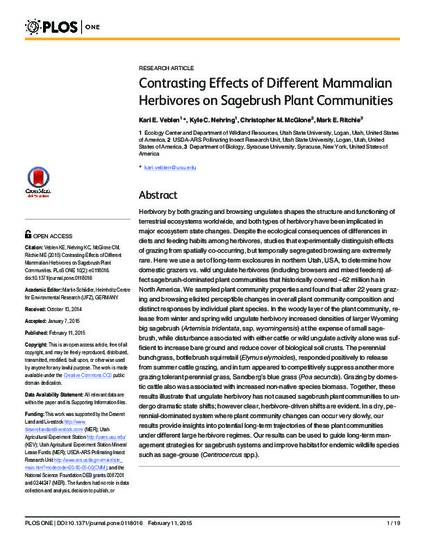
Article
Contrasting Effects of Different Mammalian Herbivores on Sagebrush Plant Communities
PLOS ONE
(2015)
Abstract
Herbivory by both grazing and browsing ungulates shapes the structure and functioning of terrestrial ecosystems worldwide, and both types of herbivory have been implicated in major ecosystem state changes. Despite the ecological consequences of differences in diets and feeding habits among herbivores, studies that experimentally distinguish effects of grazing from spatially co-occurring, but temporally segregated browsing are extremely rare. Here we use a set of long-term exclosures in northern Utah, USA, to determine how domestic grazers vs. wild ungulate herbivores (including browsers and mixed feeders) affect sagebrush-dominated plant communities that historically covered ~62 million ha in North America. We sampled plant community properties and found that after 22 years grazing and browsing elicited perceptible changes in overall plant community composition and distinct responses by individual plant species. In the woody layer of the plant community, release from winter and spring wild ungulate herbivory increased densities of larger Wyoming big sagebrush (Artemisia tridentata, ssp. wyomingensis) at the expense of small sagebrush, while disturbance associated with either cattle or wild ungulate activity alone was sufficient to increase bare ground and reduce cover of biological soil crusts. The perennial bunchgrass, bottlebrush squirretail (Elymus elymoides), responded positively to release from summer cattle grazing, and in turn appeared to competitively suppress another more grazing tolerant perennial grass, Sandberg’s blue grass (Poa secunda). Grazing by domestic cattle also was associated with increased non-native species biomass. Together, these results illustrate that ungulate herbivory has not caused sagebrush plant communities to undergo dramatic state shifts; however clear, herbivore-driven shifts are evident. In a dry, perennial- dominated system where plant community changes can occur very slowly, our results provide insights into potential long-term trajectories of these plant communities under different large herbivore regimes. Our results can be used to guide long-term management strategies for sagebrush systems and improve habitat for endemic wildlife species such as sage-grouse (Centrocercus spp.).
Disciplines
Publication Date
Winter 2015
DOI
https://dx.doi.org/10.1371%2Fjournal.pone.0118016
Citation Information
Kari E. Veblen. "Contrasting Effects of Different Mammalian Herbivores on Sagebrush Plant Communities" PLOS ONE Vol. 10 Iss. 2 (2015) p. e0118016 Available at: http://works.bepress.com/kari_veblen/39/
